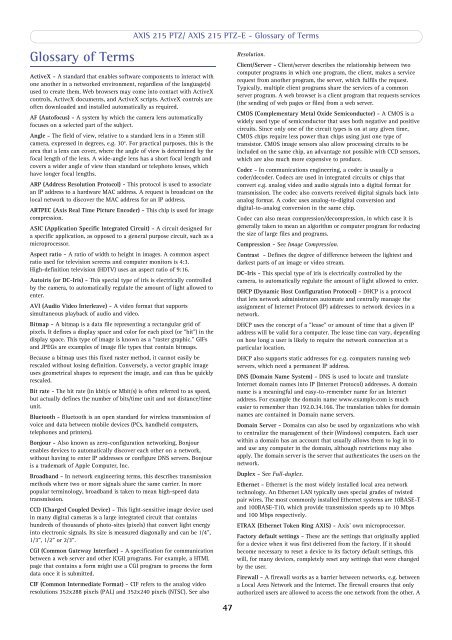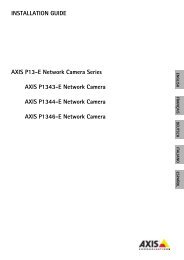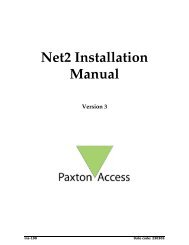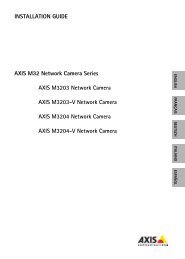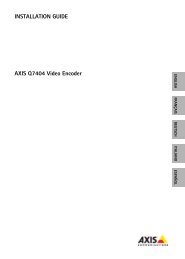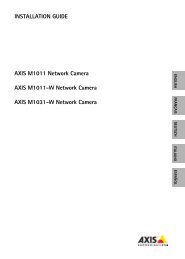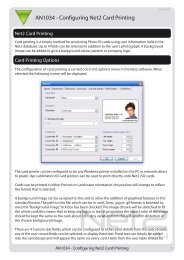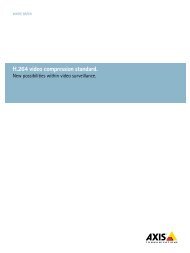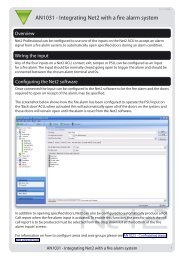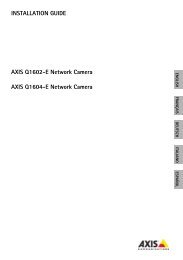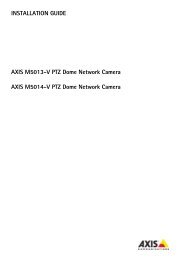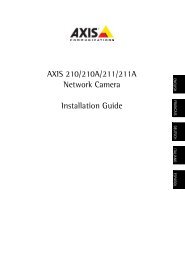Create successful ePaper yourself
Turn your PDF publications into a flip-book with our unique Google optimized e-Paper software.
AXIS <strong>215</strong> PTZ/ AXIS <strong>215</strong> PTZ-E - Glossary of TermsGlossary of TermsActiveX - A standard that enables software components to interact withone another in a networked environment, regardless of the language(s)used to create them. Web browsers may come into contact with ActiveXcontrols, ActiveX documents, and ActiveX scripts. ActiveX controls areoften downloaded and installed automatically as required.AF (Autofocus) - A system by which the camera lens automaticallyfocuses on a selected part of the subject.Angle - The field of view, relative to a standard lens in a 35mm stillcamera, expressed in degrees, e.g. 30°. For practical purposes, this is thearea that a lens can cover, where the angle of view is determined by thefocal length of the lens. A wide-angle lens has a short focal length andcovers a wider angle of view than standard or telephoto lenses, whichhave longer focal lengths.ARP (Address Resolution Protocol) - This protocol is used to associatean IP address to a hardware MAC address. A request is broadcast on thelocal network to discover the MAC address for an IP address.ARTPEC (<strong>Axis</strong> Real Time Picture Encoder) - This chip is used for imagecompression.ASIC (Application Specific Integrated Circuit) - A circuit designed fora specific application, as opposed to a general purpose circuit, such as amicroprocessor.Aspect ratio - A ratio of width to height in images. A common aspectratio used for television screens and computer monitors is 4:3.High-definition television (HDTV) uses an aspect ratio of 9:16.Autoiris (or DC-Iris) - This special type of iris is electrically controlledby the camera, to automatically regulate the amount of light allowed toenter.AVI (Audio Video Interleave) - A video format that supportssimultaneous playback of audio and video.Bitmap - A bitmap is a data file representing a rectangular grid ofpixels. It defines a display space and color for each pixel (or "bit") in thedisplay space. This type of image is known as a "raster graphic." GIFsand JPEGs are examples of image file types that contain bitmaps.Because a bitmap uses this fixed raster method, it cannot easily berescaled without losing definition. Conversely, a vector graphic imageuses geometrical shapes to represent the image, and can thus be quicklyrescaled.Bit rate - The bit rate (in kbit/s or Mbit/s) is often referred to as speed,but actually defines the number of bits/time unit and not distance/timeunit.Bluetooth - Bluetooth is an open standard for wireless transmission ofvoice and data between mobile devices (PCs, handheld computers,telephones and printers).Bonjour - Also known as zero-configuration networking, Bonjourenables devices to automatically discover each other on a network,without having to enter IP addresses or configure DNS servers. Bonjour of Apple Quick Computer, <strong>User</strong>’s Inc. <strong>Guide</strong>Broadband - In network engineering terms, this describes transmissionmethods where two or more signals share the same carrier. In morepopular terminology, broadband is taken to mean high-speed datatransmission.CCD (Charged Coupled Device) - This light-sensitive image device usedin many digital cameras is a large integrated circuit that containshundreds of thousands of photo-sites (pixels) that convert light energyinto electronic signals. Its size is measured diagonally and can be 1/4",1/3", 1/2" or 2/3".CGI (Common Gateway Interface) - A specification for communicationbetween a web server and other (CGI) programs. For example, a HTMLpage that contains a form might use a CGI program to process the formdata once it is submitted.CIF (Common Intermediate Format) - CIF refers to the analog videoresolutions 352x288 pixels (PAL) and 352x240 pixels (NTSC). See also47Resolution.Client/Server - Client/server describes the relationship between twocomputer programs in which one program, the client, makes a servicerequest from another program, the server, which fulfils the request.Typically, multiple client programs share the services of a commonserver program. A web browser is a client program that requests services(the sending of web pages or files) from a web server.CMOS (Complementary Metal Oxide Semiconductor) - A CMOS is awidely used type of semiconductor that uses both negative and positivecircuits. Since only one of the circuit types is on at any given time,CMOS chips require less power than chips using just one type oftransistor. CMOS image sensors also allow processing circuits to beincluded on the same chip, an advantage not possible with CCD sensors,which are also much more expensive to produce.Codec - In communications engineering, a codec is usually acoder/decoder. Codecs are used in integrated circuits or chips thatconvert e.g. analog video and audio signals into a digital format fortransmission. The codec also converts received digital signals back intoanalog format. A codec uses analog-to-digital conversion anddigital-to-analog conversion in the same chip.Codec can also mean compression/decompression, in which case it isgenerally taken to mean an algorithm or computer program for reducingthe size of large files and programs.Compression - See Image Compression.Contrast - Defines the degree of difference between the lightest anddarkest parts of an image or video stream.DC-Iris - This special type of iris is electrically controlled by thecamera, to automatically regulate the amount of light allowed to enter.DHCP (Dynamic Host Configuration Protocol) - DHCP is a protocolthat lets network administrators automate and centrally manage theassignment of Internet Protocol (IP) addresses to network devices in anetwork.DHCP uses the concept of a "lease" or amount of time that a given IPaddress will be valid for a computer. The lease time can vary, dependingon how long a user is likely to require the network connection at aparticular location.DHCP also supports static addresses for e.g. computers running webservers, which need a permanent IP address.DNS (Domain Name System) - DNS is used to locate and translateInternet domain names into IP (Internet Protocol) addresses. A domainname is a meaningful and easy-to-remember name for an Internetaddress. For example the domain name www.example.com is mucheasier to remember than 192.0.34.166. The translation tables for domainnames are contained in Domain name servers.Domain Server - Domains can also be used by organizations who wishto centralize the management of their (Windows) computers. Each userwithin a domain has an account that usually allows them to log in toand use any computer in the domain, although restrictions may alsoapply. The domain server is the server that authenticates the users on thenetwork.Duplex - See Full-duplex.Ethernet - Ethernet is the most widely installed local area networktechnology. An Ethernet LAN typically uses special grades of twistedpair wires. The most commonly installed Ethernet systems are 10BASE-Tand 100BASE-T10, which provide transmission speeds up to 10 Mbpsand 100 Mbps respectively.ETRAX (Ethernet Token Ring AXIS) - <strong>Axis</strong>' own microprocessor.Factory default settings - These are the settings that originally appliedfor a device when it was first delivered from the factory. If it shouldbecome necessary to reset a device to its factory default settings, thiswill, for many devices, completely reset any settings that were changedby the user.Firewall - A firewall works as a barrier between networks, e.g. betweena Local Area Network and the Internet. The firewall ensures that onlyauthorized users are allowed to access the one network from the other. A


